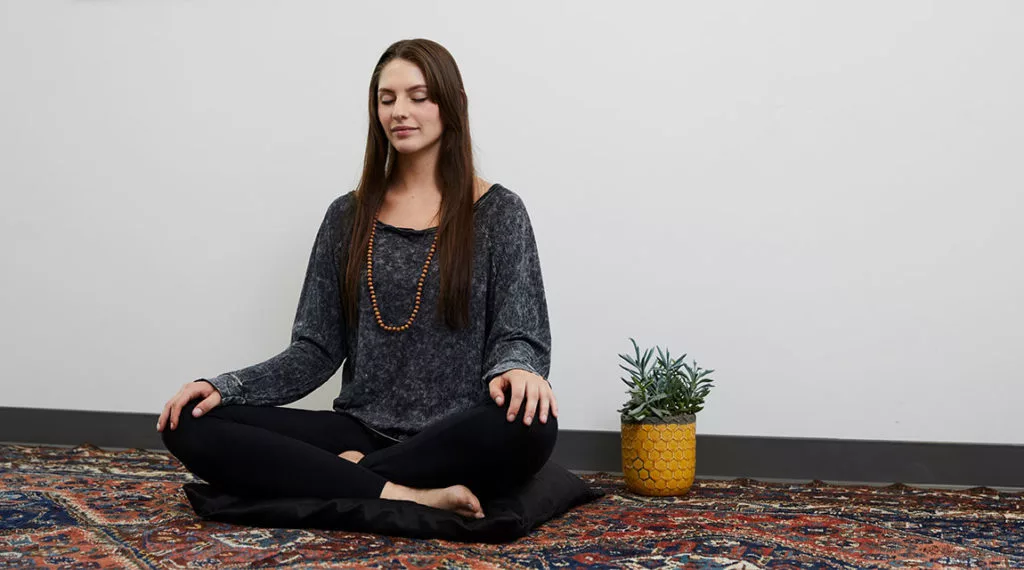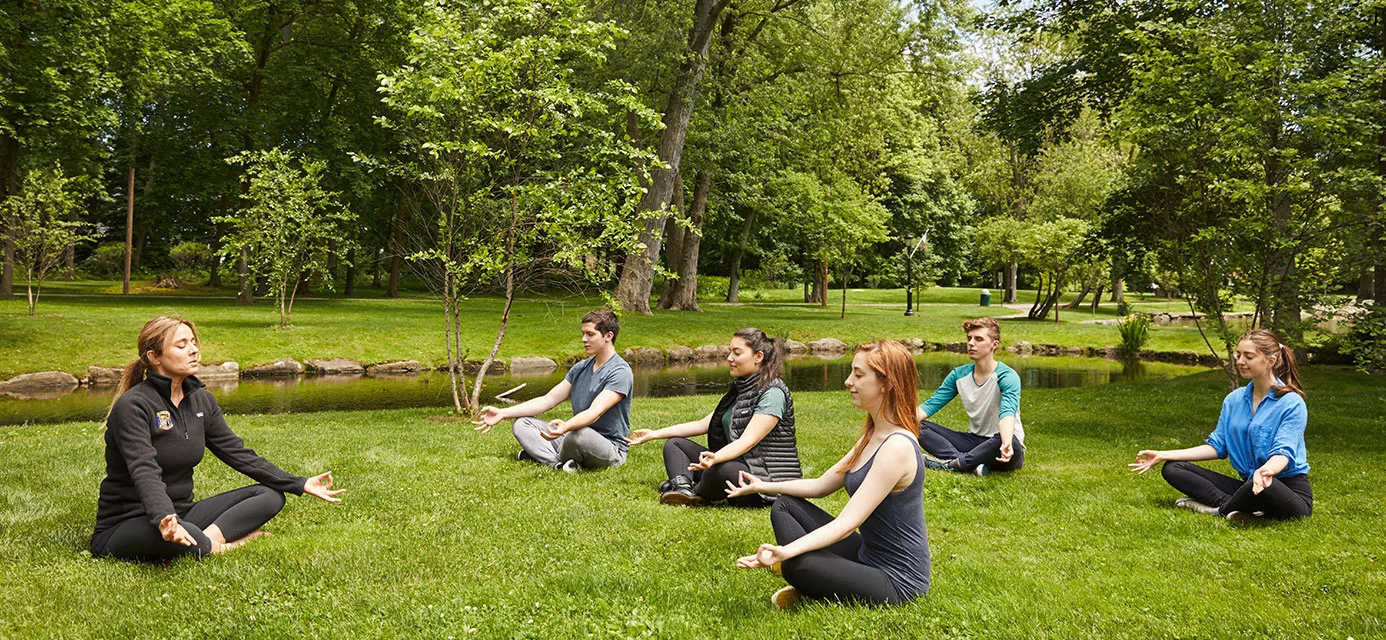Today’s teens suffer more from anxiety and stress than any American generation before them. Therefore, relaxation skills for teens are essential.
Relaxation techniques provide beneficial ways of dealing with stress. Hence, teens have a better chance of avoiding unhealthy coping mechanisms, such as substance abuse and self-harming.
Thus, scientists are bringing new research to the forefront regarding natural and holistic relaxation techniques. And therapists and healthcare professionals are offering young people these effective alternatives to medication.
The Power of Yoga for Anxiety
How does yoga relieve anxiety? Researchers theorize that the mindful movement and breathing done in yoga activates the relaxation response. Therefore, yoga moves us out of the sympathetic nervous system (“fight or flight”). Hence, it moves us into the parasympathetic nervous system (“rest and digest”) system.
Furthermore, yoga practice increases levels of GABA. GABA is the neurotransmitter in the brain that helps relax the mind. In a 12-week study, participants either walked or did yoga for an hour three times a week. The yoga group showed greater increases in GABA levels. In addition, they showed greater improvement in mood and anxiety. As a result, yoga is one of the most important relaxation skills for teens.
A Yoga Relaxation Exercise
Child’s pose is a simple yoga posture that is known for its ability to encourage relaxation. Thus, it is an ideal relaxation skill for teens. Here’s how to practice Child’s pose.
- From hands and knees, lower your hips toward your heels.
- Spread your knees wide apart while keeping your big toes touching. Soften the belly onto the tops of the thighs.
- Rest your forehead on the floor and rest your torso on your thighs. Knees can be together or apart.
- Extend your arms forward, with palms facing down, or bring them back to rest alongside your thighs, with palms facing up.
- Breathe in for a slow count of five, then breathe out for a slow count of five.
- Stay in the pose for as long as you wish.
The Breath: One of the Most Powerful Relaxation Skills for Teens
Conscious, controlled breathing is one of the easiest and most immediate ways to relax the nervous system. Slowing the breath moves us into the relaxation response governed by the parasympathetic nervous system. Therefore, the breath is another of the most effective relaxation techniques for teens.
Teens can effectively use a deep breathing exercise to relax before tests, calm down when they’re feeling upset or stressed, and get to sleep more easily. “Space in the breath creates space in the mind for quiet and concentration,” says Nicole Renée Matthews, Director of Yoga at Newport Academy. Hence, her role includes teaching deep breathing to teens.

Research on Breathing Techniques for Teens
Research validates breathing exercises as effective, accessible tools for calming the nervous system. Moreover, these relaxation techniques work in a short amount of time.
For example, in a 2016 study, scientists at the Medical University of South Carolina divided 20 healthy adults into two groups. Next, one group did two sets of 10-minute breathing exercises. At the same time, the other group read a text of their choice for 20 minutes.
During these activities, researchers tested the subjects’ saliva at various intervals. Hence, the results showed that the saliva of participants who did the breathing exercise had much lower levels of three specific cytokines (proteins produced by cells). These cytokines are associated with stress. As a result, researchers concluded that the breathing exercises produced a measurable decrease in stress.
Square Breathing Exercise for Relaxation
Square Breathing is also known as four-square breathing or box breathing. This deep breathing exercise can serve as a go-to relaxation skill for teens.
- Sit comfortably in a chair, with your feet on the floor and hands in your lap.
- Inhale slowly through the nose for a count of four, allowing the air to fill your belly.
- Hold the breath in for a count of four.
- Exhale slowly through the mouth for a count of four.
- As you breathe, visualize a healing blue or white light washing over your body. Finally, hold the breath for a count of four.
- Repeat the sequence for four minutes.
- Ideally, repeat the exercise for four minutes, four times a day.
- Consequently, practicing Square Breathing several times daily will help teens become calmer and more relaxed.
Relaxation Skills for Teens: Meditation
Research shows that mindfulness-based exercises like meditation help decrease anxiety, depression, and stress. Furthermore, they improve mental health and quality of life. Hence, they are an important relaxation technique for teens, as well as children and adults.
In fact, a study showed that meditation is more effective than a vacation for improving mental health and increasing relaxation. A total of 90 participants were divided into three groups. The group of experienced meditators went to a meditation retreat. Moreover, a group who had never meditated also did a meditation retreat. Furthermore, the third group did not participate in meditation. Instead, they listened to health lectures and did fun vacation activities for a week. Afterward, everyone felt more relaxed.
However, 10 months later, researchers went back to the participants. And they found that both the regular and the new meditators still showed significant improvements in anxiety and depression levels. However, the vacationers had returned to the same levels they showed before the vacation. Therefore, meditation clearly has a powerful and long-lasting impact on state of mind.

Basic Mindfulness Meditation
Here are directions for a basic meditation that can be added to a teen’s toolkit of relaxation skills.
- Sit quietly with eyes closed and breathe normally.
- Bring your attention to your breath. Repeat the phrases “breathing in, breathing out” to help keep the mind focused on inhaling and exhaling.
- When a thought comes into your mind, simply label it as “a thought” and allow it to float out of your mind like a cloud moving across the sky.
- Then gently bring your attention back to your breath. Practice for as long or as short a time as you wish. Even a few minutes of meditation can make a huge difference in your day and in your mindset.
Relaxation Skills for Teens: Music
Scientists have found that rhythm has a significant impact on the nervous system. Specifically, simply listening to music has a measurable positive effect on the psychobiological stress system. Hence, it encourages deep relaxation.
“Every cell in our body operates under the organizing principle of rhythm, and they’re all functioning in concert,” says Tim Ringgold, Music Therapist at Newport Academy. “Our heartbeat, sleep cycle, and breathing are all controlled by rhythm.”
Because our bodies automatically respond to external rhythm, we can up-regulate or down-regulate the nervous system, Tim says. “We don’t have to be dependent on external devices or substances for relaxation. We can use music to do the same thing far more efficiently, without side effects.”
Furthermore, research done with depressed adolescents showed that sound therapy shifted their brain activity and levels of cortisol (the “stress hormone”). As a result, researchers concluded that music had relaxing effects on their physiological and biochemical measures. Other studies show that music therapy reduces frustration, anger, and aggression.

Time in Nature Enhances Relaxation
A growing body of research validates that time spent outdoors in nature can serve as a powerful relaxation technique for teens.
This field of study began with forest bathing in Japan. In studies on forest bathing, researchers sent some participants into forests while others were sent to an urban environment. Then they measured participants’ cortisol, blood pressure, pulse rate, and heart rate variability.
As a result, they found that forest environments, as compared to cities, produced lower cortisol, slower pulse rate, lower blood pressure, and more activity in the parasympathetic nervous system. Hence, the study showed the clear relaxation benefits of nature.
Positive Visualization Builds Relaxation Skills for Teens
Furthermore, mental imagery and visualization are powerful tools for dissolving physical and mental tension. When teenagers practice positive visualization, they learn how to regulate their emotions and relieve stress. Therefore, it is one of the most effective relaxation skills for teens.
“Visualization bypasses our logical (or illogical) mind by tapping into a global sense of ourselves and our emotions. It allows us to remember emotions, or to promote an emotional state connected to certain contexts,”
—Dr. Michel Mennesson, MD, psychiatrist at Newport Academy.
Body Scan Visualization for Relaxation
- Find a private, calm space and get settled in a comfortable position, seated or lying on your back.
- Close your eyes and take a few slow, deep breaths.
- Imagine yourself in a beautiful location, one of your favorite places to be. It might be a beach, the woods, or a cozy spot in your home or a loved one’s home.
- Visualize the environment around you. Imagine the sound of the waves, or the rustling of the wind in the trees. Feel the warmth of the sun on your face, or the coolness of the ocean spray.
- Stay in the scene, visualizing every aspect of it.
- Remember that you can return to this place whenever you want or need to relax.
This visualization is especially helpful when teens are feeling tense, unfocused, or upset. Hence, it empowers them to practice self-awareness. As a result, they can focus on consciously relaxing the body to calm the mind.
In summary, teens can draw from a wide range of anxiety exercises for youth. Consequently, they can develop a set of coping skills to reach for during times of stress. As a result, relaxation skills for teens can have a long-lasting positive impact.
Photos by Newport Academy.
Sources:
Med Hypotheses. 2012 May;78(5):571–9.
J Altern Complement Med. 2010 Nov;16(11):1145–52.
BMC Complement Altern Med. 2016 Aug 18;16:294.
Transl Psychiatry. 2016 Aug 30;6(8):e880.
PLoS One. 2013; 8(8): e70156.






